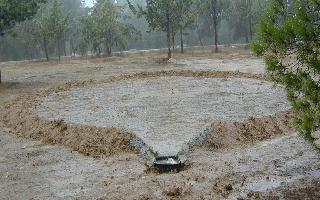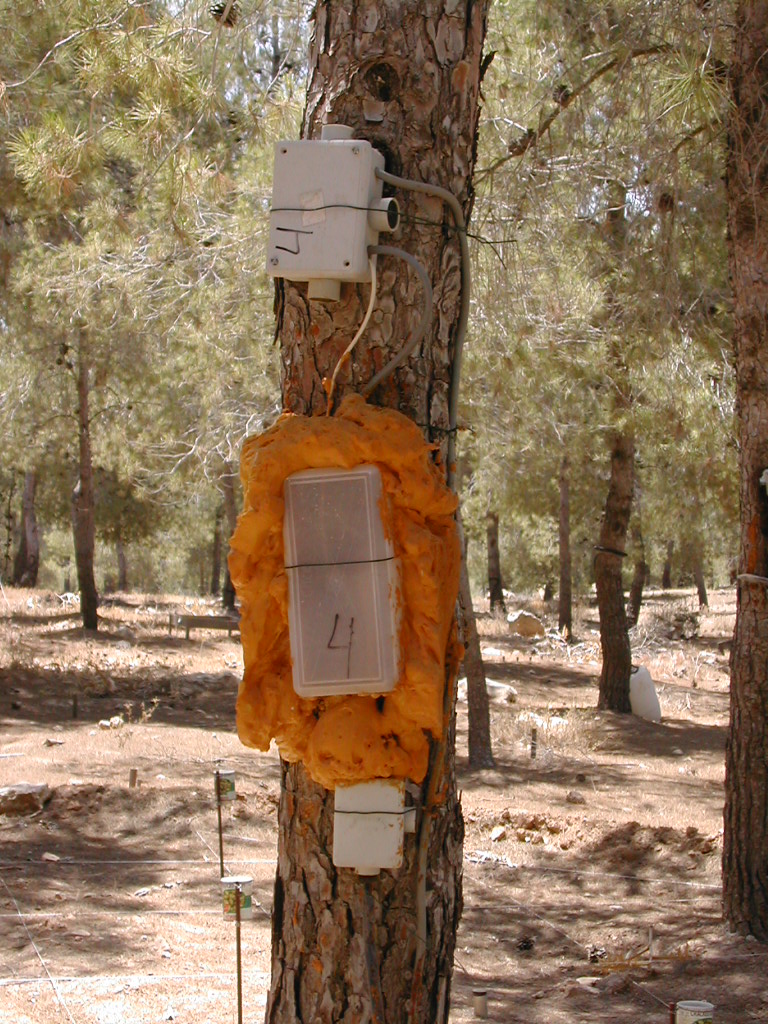Back to Agriculture > Water and Afforestation

Fig. 3. Rainfall in non-forested control area in Yatir Forest study.
The BIDR group headed by Prof. Pedro R. Berliner and supported by the KKL-JNF has made detailed measurements within the Yatir Forest, comparing these results with those of a close-by, nonforested area. In one of several unexpected findings, the researchers discovered that essentially 95 percent of annual rainfall reaches the soil and is not trapped by the tree leaves. They believe that this results from the particular architecture of the vegetative canopy and the relatively modest density of the trees. In addition, they found that in three years of measurements, the average water uptake by the small annual plants and shrubs in the nonforested clearing were very similar to that taken up by the forest vegetation.

Fig. 4. Tree with heat pulsedevice for sap-flow determination of transpiration.
For most of the year, they also measured transpiration values directly with the aid of sap-flow determinations using the heat pulse technique. For the few completely dry months, transpiration was estimated from changes in soil water content. In a typical year with rainfall amounting to 307 mm (2001-2002), 76% of the precipitation was returned to the atmosphere via transpiration, 20% escaped via evaporation off the ground and vegetation cover, with a negligible 4% going into runoff or ground water stores. Detailed Table of Water-Balance Measurements in the Yatir Forest.
The BIDR studies have also shown that the Yatir Forest provides greenery cover throughout the year, a much more effective protection of the ground than when areas contain only annual plants. The forest canopy thereby significantly affects the radiation balance at the soil surface as well as its dissipation, leading to less water evaporation from atop the soil than found in the clearings. This effect enhances the amount of water available to the trees. The overall yearly water balance in Yatir indicated that roughly 75% of rainfall was taken up by the trees, with only some 20% lost to the atmosphere by evaporation and some 5% being lost via runoff or infiltration into the aquifer.
The Blaustein team is now working on developing a general model of forest-water interactions, which would take into consideration soil parameters, planting density, climate, and rainfall distribution and intensity, among other factors. The refined model should enable researchers to predict of the effects of planting pine forests in various regions on the health of the local ecosystem and, in particular, on its water balance.
Support
These studies have been steadily supported by the Keren Kayemeth LeIsrael – Jewish National Fund, which has made available their Yatir Forest facilities, including earth-moving equipment, water tankers and tractors. In addition, the KKL provided direct grant support for the studies of Amnon Schwartz (Hebrew University of Jerusalem), Pedro R. Berliner and Dan Yakir (Weizmann Institute of Science). A grant to D. Yakir for the establishment of the site’s infrastructure was provided by the Israel Science Foundation. This work was partially supported by a grant from USAID/MERC.
Previous section